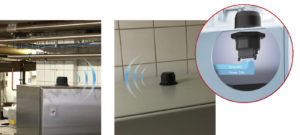 The Swedish bakery Östras bröd has been baking bread since 1899. But just because you have long traditions doesn’t mean you can’t use new technology. The bakery’s brand new baking machine has a state-of-the-art controlling systems built on Siemens controls – and wireless technology from HMS Industrial Networks.
The Swedish bakery Östras bröd has been baking bread since 1899. But just because you have long traditions doesn’t mean you can’t use new technology. The bakery’s brand new baking machine has a state-of-the-art controlling systems built on Siemens controls – and wireless technology from HMS Industrial Networks.
The machine builder is Austrian Softtec who specializes in innovative automation solutions for bakeries.
The problem
The baking machine consists of several large cylinder-shaped containers which hold the dough during the process. The cylinders are slowly spinning around like a carousel which makes it possible to fill them with flour and water, but it also makes wiring unwieldy. Also, the control cabinet is on the other side of the room which complicates wiring even further.
The solution
 To solve this issue, Softech installed the Anybus Wireless Bolt-solution from HMS. The Anybus Wireless Bolt establishes a very reliable wireless connection via Bluetooth or Wireless LAN for up to 100 meters. The top part of the Wireless Bolt is mounted on to the exterior, while the bottom is on the inside connecting to the machine (via Ethernet).
To solve this issue, Softech installed the Anybus Wireless Bolt-solution from HMS. The Anybus Wireless Bolt establishes a very reliable wireless connection via Bluetooth or Wireless LAN for up to 100 meters. The top part of the Wireless Bolt is mounted on to the exterior, while the bottom is on the inside connecting to the machine (via Ethernet).
In the case of Softtec’s baking machine, the Wireless Bolt is used as cable replacement from the machine to the main controlling cabinet on the other side of the room. Softtec has mounted one Wireless Bolt on the top of the baking machine, and another Wireless Bolt on the top of the control cabinet, about 10 meters away.
“The alternative to using wireless communication here, would be to use slip-rings,” says Andreas Kisch at Softtec. “But everything that moves and turns wears down after a while so we decided to go with a wireless solution that does not require any maintenance.”
PROFINET over Bluetooth
Data is sent between the two Wireless Bolts via Bluetooth. Softtec first tried using WLAN but found out that the busy environment in the bakery (with lots of other radio traffic and stainless steel to reflect radio waves) was better suited for Bluetooth communication. As Bluetooth uses narrow frequency band channels and actively switches frequency to find a good connection, it is often best if a robust and stable connection is needed, while WLAN is better for large data transfer.
Since it is a Siemens-based control system, the communication is handled using PROFINET I/O. Bluetooth is the preferred choice for I/O communication via PROFINET so that was also another reason to use Bluetooth. The I/O data cycle time was set to 64 milliseconds.
A reliable solution for future use
Soon, the new baking machine will be making bread for the citizens of Southern Sweden. And Softtec has found a wireless solution that they can definitely rely on in their future installations around the world.
“The installation process was pretty much plug and play,” says Andreas Kisch. “We got a little bit of help from HMS, they walked us through the process and it was quite easy. In the end, we have saved quite a bit of money on not having to use expensive slip-rings and we did not have to run a single cable.”
